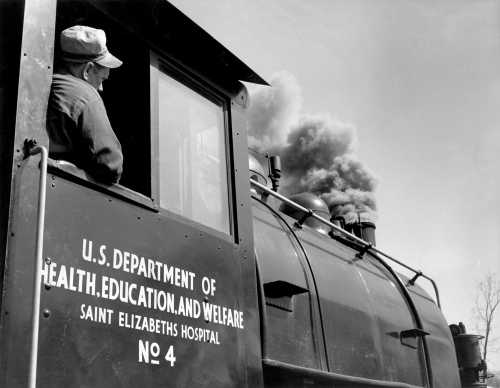FAQ: A. Aubrey Bodine's 'The Railroad that Stuck to Steam (1959)' Photograph and Career

Summary
What is the main subject of A. Aubrey Bodine’s photograph ‘The Railroad that Stuck to Steam (1959)’?
The photograph shows Engineer Otis Nevitt at the throttle of a steam locomotive used on the grounds of St. Elizabeth’s Hospital in Washington, DC.
Who was A. Aubrey Bodine and why is he significant in photography?
A. Aubrey Bodine (1906-1970) was regarded as one of the finest pictorialists of the twentieth century, winning numerous awards and having his work exhibited in prestigious shows and museums worldwide.
How can I order a print of this specific photograph?
You can order this image by typing the 5-digit ID# 48-266 in the box below Bodine’s portrait on the Home Page at www.aaubreybodine.com.
What made Bodine’s photographic approach unique and artistic?
Bodine treated photography as a creative discipline, using techniques like composing in the viewfinder, working on negatives with dyes and intensifiers, pencil marking, scraping, and adding clouds photographically to create artistic effects beyond standard newspaper work.
Where did Bodine’s photographic career begin and what type of work did he do?
Bodine’s career began in 1923 covering stories for the Baltimore Sunday Sun, where he traveled throughout Maryland creating remarkable documentary pictures of various occupations and activities with exceptional artistic quality.
How many photographs are available from Bodine’s career and where can they be viewed?
More than 6,000 photographs spanning Bodine’s 47-year career are available for viewing and can be ordered as reprints and note cards at www.aaubreybodine.com.
What additional resources are available to learn more about A. Aubrey Bodine?
The full biography ‘A Legend In His Time’ by Harold A. Williams is available on the website, and you can contact [email protected] or call 1-800-556-7226 for additional information.
What was Bodine’s philosophy about photography and image creation?
Bodine believed that ’the picture was the thing, not the manner of arriving at it’ - he didn’t take pictures, he made pictures, selecting features that suited his sense of mood, proportion and design like a painter working from a model.

This story is based on an article that was registered on the blockchain. The original source content used for this article is located at citybiz
Article Control ID: 178897